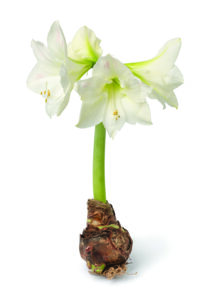
Amaryllis prefer to be watered regularly and like bright, indirect light.
Merry Christmas and Happy Holidays, gardeners! We’re in Winter Wonderland mode here. How about you?
From everyone here at Robin’s Nest, we hope you have a wonderful holiday season and happy new year! Thank you for 41 great years and counting.
Most of your gardening activity likely will be indoors this month. Regular checking of houseplants for watering and pests is recommended. Signs of overwatering include the soil is always wet to the touch, leaves are yellowing, stems are soft and squishy, the leaves have brown edges or spots, and/or the soil is attracting pests.
Make sure your plants have adequate drainage. Plastic pots hold much more water, so if you tend to overwater, consider terracotta pots instead since they’re great at absorbing excess water. It’s much better for your plants to be a little too dry, than too wet.
The outdoor gardening season may be over, but indoors you can still grow herbs. If you’d like to start some herbs, sow seeds of parsley, oregano, sage, chives, and dwarf basil in clay pots.
Once they germinate, place them under grow lights, water when dry, and fertilize with a half-strength solution. There’s nothing like having fresh herbs for your cold season cooking.
If you’re still looking to get outside despite the cold, trees and shrubs can still be pruned. Make sure to prune any diseased pieces and make any necessary cosmetic cuts. Evergreens such as hollies, boxwoods and pines can also be moderately pruned this month. Those trimmings can be used for holiday decorating such as wreaths or garland.
Let’s get into care tips for some holiday houseplant favorites. Poinsettias, amaryllis, cyclamen, and Christmas cactus are all plants that are typically in their prime during the holiday season.
Poinsettias love warmth and light, making them perfect for a bedroom or living room. Keep away from drafty areas such as doorways, open windows, and fireplaces. If you have hard water in your home you may want to boil it first and let it cool or let it sit out for a day before using it to water your poinsettia. And fluoride in city water is not good for them, either, so distilled water may be your best option.
Either way, do not use water that is cold in temperature. Only water when they’re noticeably dry.
Poinsettias do like humid conditions, so keep them misted if it’s in a room where the central heating is on constantly. Both poinsettias and amaryllis are heavy feeders, so we recommend mixing a full-strength blossom booster into a gallon of water, then you can use the mixture to water when needed.
Amaryllis prefer to be watered regularly and like bright, indirect light. A support stake is handy for keeping the blooms upright, if need be. Most varieties will begin blooming six to eight weeks after planting; some can take as long as 10 weeks. Potting soil will provide more drainage for your amaryllis than garden soil. As the plant grows, turn the pot periodically to encourage the flower stalks to grow straight. To prolong the blooms, keep your amaryllis out of direct sunlight.
Some amaryllis bulbs sprout leaves first, and then the flower stalk emerges a little later. Others send up the flower stalk first, followed by the leaves.
Cyclamen need a cool, bright spot to thrive, but keep them away from direct sunlight. Keep the soil moist but don’t overwater — this is the usual way cyclamen is killed. Water once the soil begins to feel dry.
Stand the plant in a saucer or shallow bowl of water for an hour or so until the soil is moist but not soaking wet. Let any excess water drain away. If you water cyclamen with a watering can, water will splash onto the leaves and cause mildew. Cyclamen don’t need much feeding — otherwise they will produce lots of foliage rather than flowers. Feed every couple of months with a houseplant fertilizer if you’re planning on keeping your plant from year to year; if not — no need to bother. Remove any dead or dying flowers or leaves by tugging them away gently.
Holiday cacti are native to tropical rainforests and need regular water to remain healthy. A lack of water and dramatic temperature swings can cause flower buds to drop more rapidly.
They prefer partial shade or diffused light. Direct sun is alright as long as it’s during the winter — direct sun in the spring and summer will cause paleness and yellowing. Prune your holiday cactus right after it blooms, when it enters a new growth period extending its growth segments. Pruning will force the plant to branch out, and it will grow more of its distinctive stems. Grow your holiday cactus as a hanging plant or place it where it has room to drape if you want to encourage the stems even more. Holiday cacti are not frost tolerant and can only handle nighttime temperatures of around 60 degrees, so it’s better to keep them as indoor plants. The best way to ensure that your holiday cactus remains in bloom throughout the winter is by removing the faded flowers or deadheading.
Are you looking to prolong the life of your fresh tree, wreath or garland? First, never display a fresh green wreath in between the storm and front doors. The intensity of the sun will bake the wreath and turn it brown. Consider using an anti-transpirant or anti-desiccant plant spray on your fresh greenery.
The sprays can help keep your fresh seasonal greenery from losing moisture since they’re developed to protect plants in drought-prone areas.
(Editor’s Note: Ken Morgan is the owner of Robin’s Nest Floral and Garden Center in Easton, Md.)



